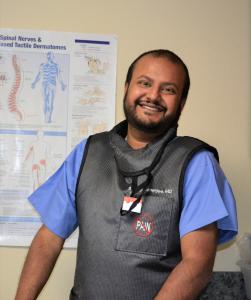
Phantom Limb Pain, explained by Dr. Sanjoy Banerjee in a new article
If you want to know more about phantom limb pain, its causes, and symptoms, Sanjoy Banerjee, MD of Pacific Pain Care published an explanatory article about it.
Pacific Pain Care (N/A:N/A)
Dr. Sanjoy Banerjee, who focuses on Pain Management, shares his thoughts in a new article, which is available on his blog at https://sanjoybanerjeemd.home.blog/
These pain-inducing sensations are often reported to be irritating, whereas the pain itself ranges from mild to intense, depending on how badly the limb was severed. Mostly diagnosed in war veterans, stuntmen, and extreme sports players, phantom pain is also experienced by people who have been paralyzed. The pain either decreases over time or dies down completely; however, in some cases, it may also require medical attention.
People suffering from phantom limb pain often display signs and symptoms that are a clear give away of the medical condition, such as a sharp, throbbing, stabbing, or burning pain in the limb area. Patients may also complain about the uncomfortable positioning of the phantom limb or a tingling or itching sensation arousing.
Other than these symptoms, patients can also experience certain sensations. For instance, phantom limb pain patients frequently complain about sensations associated with the limb's posture, length, and weight. For example, people report sensations of the phantom limb feeling heavier. At times, people also complain about how the limb has shrunk. This feeling is called telescoping.
Other sensory features include movements where the patient feels his limb is moving or that he can control its movement, when in reality, the limb is absent. Similarly, they may report senses of touch, temperature, pressure, and itchiness because they feel the limbs are warm or cold or burning.
This post-amputation medical condition is preventable. Since the developmental risk of phantom limb pain is higher in patients who have suffered pain in that limb prior to surgery, surgeons and physicians encourage the use of anesthesia ahead of amputation surgery. The anesthesia can either be spinal or epidural and can be administered a few hours or even days before the surgery takes place. This prevention method has reportedly seen a significant decline in prevailing phantom limb pain together with the immediate pain reduction after surgery.
Although not every amputee develops a phantom limb ache, most people do because they are at a higher developmental risk of phantom pain. Certain factors increase the risk of phantom pain of the limbs, such as factors like pre-existing pain in the limbs that are later amputated.
Researchers suggest that patients with pre-existing limb pain are more likely to suffer from phantom limb pain after the surgical procedure. This is because of how their brains develop sensory memories of pain and continue to send this signal even once the limb is removed.
Residual limb pain is another risk factor of phantom pain. Individuals with constant pain in the residual part of the limbs generally do experience phantom pain. This is due to the abnormal growth of damaged nerve endings, called neuroma, which consequently lead to painful nerve activity.
If you have recurrent sensations of movement, pain, or touch in your phantom limbs, it is highly advised to seek medical assistance.
Dr. Sanjoy Banerjee, M.D., QME (Corona & Wildomar, California)
Dr. Sanjoy Banerjee is the Founder and Medical Director of Pacific Pain Care in Corona and Wildomar, California. He graduated medical school from Imperial College, School of Medicine in London, England, and completed his Anesthesiology Residency at the University of Rochester, New York. In addition, Dr. Banerjee completed the ACGME accredited Pain Management Fellowship Program at the University of California at Davis.
References
Website: http://www.pacificpaincare.com/doctors
Blog: https://sanjoybanerjeemd.home.blog/
Blog of Pacific Pain Care: https://www.pacificpaincare.com/blog
News: https://medicogazette.com/dr-sanjoy-banerjee
News: https://hype.news/dr-sanjoy-banerjee/
News: https://hippocratesguild.com/dr-sanjoy-banerjee
LinkedIn: https://www.linkedin.com/in/sanjoy-banerjee-a57079186/
Doctor Profile: https://www.vitals.com/doctors/Dr_Sanjoy_Banerjee.html
Article on LinkedIn: https://www.linkedin.com/pulse/medical-doctor-dr-sanjoy-banerjee-starts-blog-pain-related-banerjee
Youtube: https://www.youtube.com/user/PacificPainCare
Facebook: https://www.facebook.com/Pacific-Pain-Care-1751511985128467/
Other professional references:
https://pdfs.semanticscholar.org/4e70/5b427db75d9402d96d2f8398e9d9cc2f055e.pdf
http://cancercenter.ucdavis.edu/pain/Pain%20Resources/QinterstitialCystitis_Banerjee.pdf
https://www.ncbi.nlm.nih.gov/pubmed/20718649#
https://www.tandfonline.com/doi/abs/10.3109/15360288.2010.503985
https://medschool.ucr.edu/community-based-faculty
http://www.llu.edu/pages/faculty/directory/index2.html?dept=Medicine
Dr. Sanjoy Banerjee
Pacific Pain Care
+18558547246
email us here
Visit us on social media:
Facebook
LinkedIn
Dr. Sanjoy Banerjee, Pacific Pain Care - Post stroke pain Testimonial.
EIN Presswire does not exercise editorial control over third-party content provided, uploaded, published, or distributed by users of EIN Presswire. We are a distributor, not a publisher, of 3rd party content. Such content may contain the views, opinions, statements, offers, and other material of the respective users, suppliers, participants, or authors.






